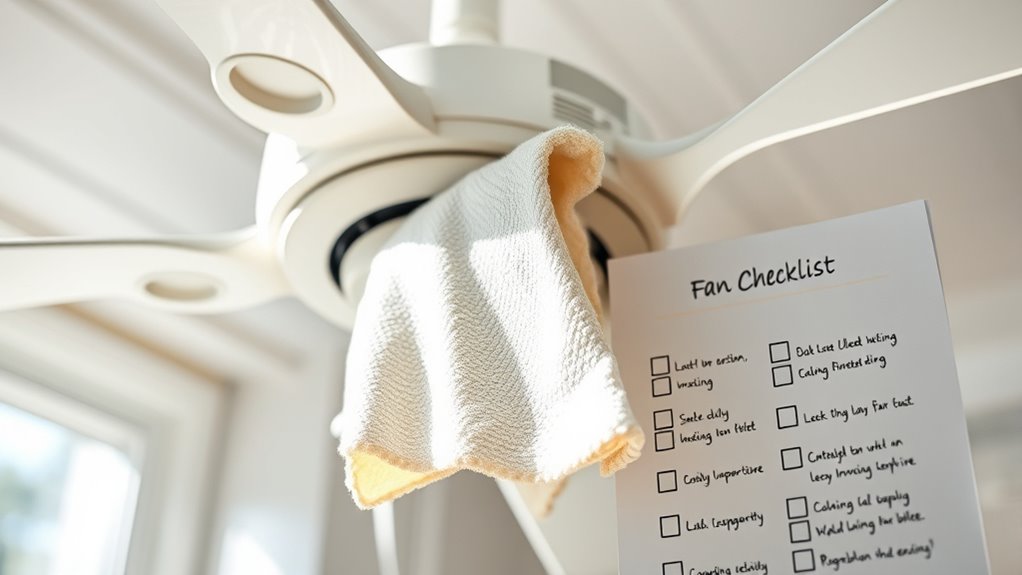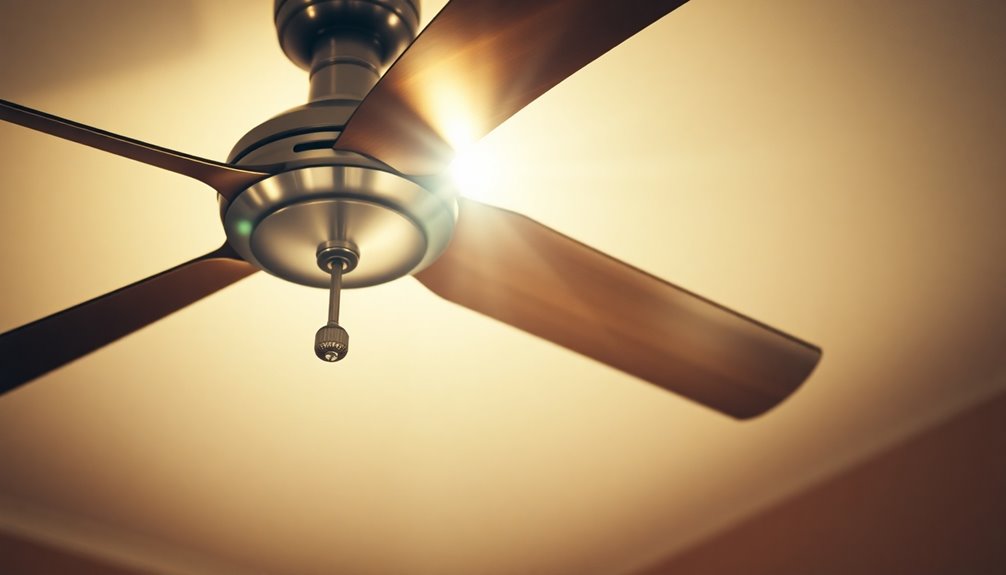To troubleshoot your fan cleaning schedule, start by inspecting for dust buildup, decreased airflow, or signs of debris on blades and vents. Clean fans every 1 to 3 months, especially in dusty areas or where pets are present. Use appropriate tools like a microfiber cloth and gentle brush, and always unplug the unit before cleaning. Staying consistent helps maintain efficiency and extends your fan’s lifespan. Keep going for more tips to optimize your routine.
Key Takeaways
- Regularly inspect fans for dust buildup, especially in dusty or pet-friendly environments, to determine cleaning needs.
- Follow a cleaning schedule every 1 to 3 months based on fan usage and environmental factors.
- Look for signs like decreased airflow, visible dirt, or increased energy bills to identify when cleaning is needed.
- Use proper tools and safety measures, such as turning off power before cleaning and gentle brushes for debris removal.
- Incorporate reminders to maintain consistent cleaning routines, ensuring optimal fan performance and longevity.
Fan Cleaning Routine and Maintenance Tips

Regularly cleaning your fans is essential to maintaining ideal airflow and preventing dust buildup. When fans are free of debris, they can operate at peak airflow efficiency, which helps keep your space comfortable and your HVAC system functioning properly. Neglecting routine cleaning can lead to reduced airflow, increased energy consumption, and even potential mechanical issues. To stay on top of this, it’s important to establish a consistent cleaning schedule and set maintenance reminders so you don’t forget to perform necessary upkeep.
One of the first things you should do is assess how often your fans need cleaning based on their environment. For instance, fans in dusty areas or homes with pets tend to accumulate grime faster, requiring more frequent attention. A good rule of thumb is to check and clean your fans every one to three months. Setting reminders on your phone or calendar can help you stick to this schedule, ensuring you don’t overlook regular maintenance. When you get into a routine of cleaning, you’ll notice improvements in airflow efficiency, as dust and dirt no longer hinder the blades or vents.
If you notice your fans aren’t moving air as effectively as they used to, it’s a clear sign that a cleaning session is overdue. Dust, pet hair, and other debris can settle on blades and vents, reducing the fan’s ability to circulate air properly. Regular maintenance not only restores ideal airflow but also prolongs the lifespan of your fans. As part of your routine, check for any signs of wear or damage, such as bent blades or loose parts, and address these issues during your cleaning sessions. This proactive approach helps prevent unexpected breakdowns and keeps your system running smoothly.
To make the process easier, gather the right cleaning tools beforehand—such as a microfiber cloth, a gentle brush, and a vacuum with a brush attachment. Make sure to turn off the fan before cleaning, and if possible, disconnect it from power to avoid accidents. Wipe down blades, grilles, and vents, removing dust and grime. For more stubborn buildup, use a damp cloth or mild cleaning solution. Remember, routine cleaning isn’t just about appearance; it directly impacts airflow efficiency and energy use. Regular maintenance reminders help you stay consistent, ensuring your fans operate at their best and contribute to a healthier indoor environment. Keeping up with this simple task can save you money on energy bills and extend the lifespan of your fans, making it a worthwhile part of your home maintenance routine. Additionally, understanding the beneficial ingredients in eye patches can help you choose products that support skin hydration and anti-aging.
Frequently Asked Questions
How Can I Tell if My Fan Needs Cleaning More Often?
You can tell if your fan needs cleaning more often by checking for dust accumulation on blades and vents, which can reduce efficiency and cause noise. Also, if you notice a strange smell when the fan runs, it’s a sign it needs cleaning. Regularly inspecting these signs helps you maintain your fan’s performance and air quality, ensuring it stays clean and odor-free with less frequent deep cleanings.
Are There Specific Cleaning Products Recommended for Fan Blades?
You can use a cleaning spray or fan polish to keep your fan blades spotless. Avoid harsh chemicals that might damage the surface; instead, opt for gentle, non-abrasive products. A microfiber cloth with a bit of cleaning spray works wonders, leaving blades shiny and dust-free. Regular cleaning with these products guarantees your fan runs efficiently and looks great, reducing the need for frequent deep cleans and extending its lifespan.
How Do I Safely Clean a Ceiling Fan Without Damaging It?
To safely clean a ceiling fan without damaging it, start by turning off the power. Use a sturdy ladder and wear gloves for safety. Apply safe cleaning techniques by gently wiping fan blades with a microfiber cloth dampened with mild soap and water, avoiding harsh chemicals. This guarantees proper fan blade maintenance and prevents damage. Regular cleaning keeps your fan functioning smoothly and maintains good air quality in your space.
What Are Signs of a Malfunction Caused by Dust Buildup?
You might notice your ceiling fan isn’t rotating smoothly or making unusual noises—these are signs of dust accumulation causing a malfunction. Dust buildup can also reduce fan performance, making it less effective at circulating air. If your fan seems sluggish or louder than usual, it’s time to check for dust. Regular cleaning prevents these issues, ensuring your fan operates efficiently and quietly, keeping your space comfortable.
Can Regular Cleaning Improve My Fan’s Energy Efficiency?
Yes, regular fan maintenance can improve your fan’s energy efficiency. Dust and dirt buildup make your fan work harder, increasing energy consumption. By cleaning your fan regularly, you reduce strain on its motor, leading to energy savings and better performance. Consistent maintenance ensures ideal airflow and cooling, helping you save on electricity bills while extending your fan’s lifespan. Keep up with routine cleaning to enjoy these benefits.
Conclusion
Keeping your fan clean isn’t just about maintenance—it’s about safeguarding the air you breathe and the comfort you cherish. Think of each cleaning as a small act of love for your home, a simple step that guarantees your fan keeps you cool and healthy. Don’t let dust and dirt steal your peace; take control today. Remember, a well-maintained fan is more than just a machine—it’s the heartbeat of your comfort.









